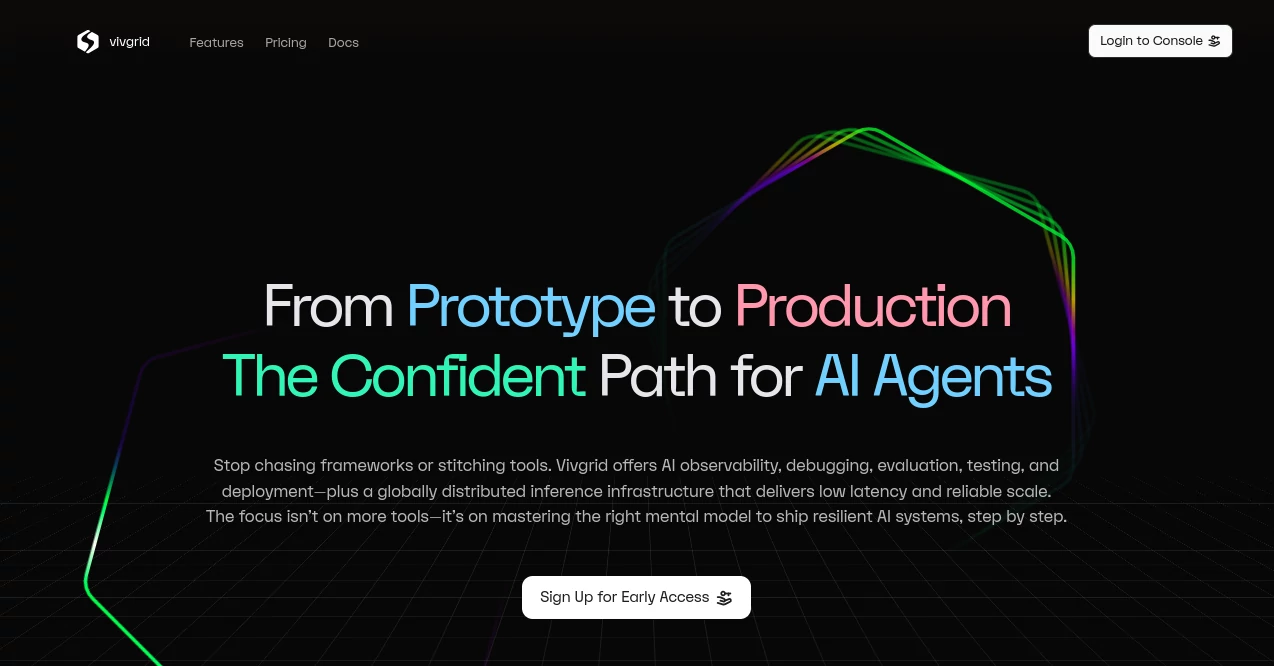vivgrid
Verified Blue CheckMark
Verified Blue CheckMark products are featured above free or unverified listings.
This badge indicates authenticity and builds trust, giving your product higher visibility across the platform.
Upgrade to get verified
Verified Blue CheckMark products are featured above free or unverified listings. This badge indicates authenticity and builds trust, giving your product higher visibility across the platform.
Upgrade to get verified
From Prototype to Production for AI Agents

What is vivgrid?
Vivgrid stands as a solid backbone for anyone aiming to bring AI agents to life, guiding them from early sketches to live operations with clear eyes on every move. It wraps around the tricky parts of agent building, offering ways to watch, tweak, and scale without the usual blind spots. Builders who've given it a spin often talk about how it cuts down the guesswork, letting them focus on what the agents can really do rather than chasing down hidden snags.
Introduction
Vivgrid came together from the shared headaches of developers who kept hitting walls when turning agent concepts into working setups. It rolled out to fill that gap, starting with a focus on making the unseen parts visible and manageable. Pretty soon, teams in support and analytics started leaning on it to handle their growing agent fleets, sharing how it sped up their launches without skimping on checks. The platform's draw comes from its hands-on approach to the full journey, pulling in real-world tweaks that keep things grounded and growing, turning what could be a bumpy ride into a steady climb toward reliable outputs.
Key Features
User Interface
The console greets you with a straightforward dashboard that lays out your agents' paths in easy-to-follow flows, from prompts to final steps. Tabs for logs and metrics slide in without fuss, and quick filters let you zero in on specific runs or issues. It's the kind of setup that gets out of the way fast, with color cues that highlight what's humming along or needing a look, so you spend less time hunting and more time fixing or fine-tuning.
Accuracy & Performance
It keeps a close eye on how agents reason through tasks, scoring their outputs against set marks to spot where things shine or slip. Runs come back in under fifty milliseconds thanks to a spread-out network of hardware, holding steady even when loads pile up. Folks running tests say it flags inconsistencies quick, helping them dial in tweaks that boost overall reliability without endless reruns.
Capabilities
From piecing together multi-step chains to routing jobs between agents, it handles the orchestration that makes complex setups tick. Memory pulls in context on the fly, so agents remember past interactions without starting cold each time. You can layer in checks for quality or safety right in the flow, and it tracks everything from costs to delays, giving you the full picture to scale or adjust as needed.
Security & Privacy
Built-in barriers catch risky moves early, like blocking off-topic drifts or flagging sensitive slips before they go live. Human oversight slots in where it counts, reviewing key spots to keep things on track. Data stays contained with standard locks, and you set the rules on what gets shared or stored, offering that extra layer of calm for teams handling real stakes.
Use Cases
Support teams string together agents for handling queries, billing lookups, and follow-ups all in one smooth handoff. Analytics outfits use it to monitor data pulls and reports, ensuring outputs stay sharp amid changing inputs. Startups prototype quick agents for testing market ideas, while bigger groups deploy fleets for ongoing ops, like routing tasks in real time to keep services humming.
Pros and Cons
Pros:
- Full views into agent steps make debugging a breeze.
- Low-latency deploys keep things snappy in production.
- Built-in scoring and guards add confidence at scale.
- Free starter credits ease the jump into building.
Cons:
- Early access might limit some advanced team features.
- Steep for total newcomers without agent basics.
- Relies on steady net for real-time tracking.
Pricing Plans
New folks get two hundred bucks in credits to kick things off, covering builds and tests without an upfront hit. Beyond that, it scales with usage—pay for what you run, from small prototypes to full fleets, keeping costs tied to real needs. No rigid tiers yet, just flexible billing that grows with you, and early birds snag extras like priority spots in the queue.
How to Use Vivgrid
Sign up through the console to claim your credits, then set up your first agent by mapping out its steps and tools. Run a test loop to watch the traces unfold, tweak based on the scores, and add guards for safety. Once solid, push to deploy on the network, keeping an eye on metrics as it goes live. Loop back with fresh data to refine, turning one-offs into steady performers.
Comparison with Similar Tools
Where some platforms stick to basic runs without deep peeks, Vivgrid layers in full traces and multi-agent links, though those might edge out for simpler solo setups. Against heavier suites, it's leaner on resources but punches hard on observability, skipping extras for focused agent work. It fits best for teams chasing production-ready flows over quick prototypes.
Conclusion
Vivgrid clears the path for AI agents to step from drawing board to daily grind, blending sharp insights with smooth scaling that builds trust along the way. It turns the art of agent crafting into a craft you can count on, yielding systems that run clean and smart. As more outfits eye agent-driven ops, this setup keeps proving its worth, lighting up possibilities that stick around for the long haul.
Frequently Asked Questions (FAQ)
What's the early access like?
Quick sign-up with credits to dive right in, plus tips to get rolling fast.
How fast does it handle deploys?
Under fifty milliseconds for inferences, keeping responses zippy.
Can it manage multiple agents together?
Yes, orchestrates workflows like support chains or analytics loops seamlessly.
What about keeping things safe?
Guards and human checks block risks before they hit production.
Is it for big teams only?
Scales from solo tinkerers to full crews, with metrics for all.
AI Monitor & Report Builder , AI Developer Tools , AI Task Management , AI Workflow Management .
These classifications represent its core capabilities and areas of application. For related tools, explore the linked categories above.
vivgrid details
Pricing
- Free
Apps
- Web Tools
















